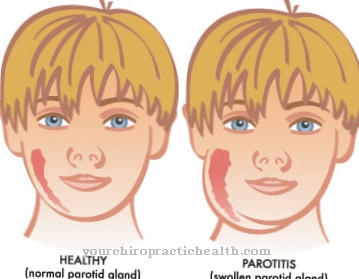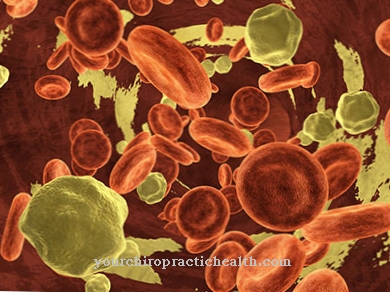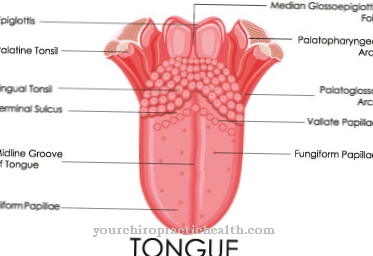In the process of creating a Enanthemums The tiny vessels of the mucous membranes (so-called capillaries) swell up due to an inflammatory reaction of the immune system. This leads to the red, blotchy color of the mucous membrane, which is typical of an enanthem and can be accompanied by swelling, burning, itching or pain.
What is an enanthem?

© Dan Race - stock.adobe.com
In medical jargon, an enanthem is any form of rash in the area of the mucous membranes, whereby in most cases the oral mucosa is affected.
These are usually reddish spots or larger red areas in the mouth or throat that can also be swollen. The appearance of vesicles is also possible with such an enanthem.
causes
Various causes can be blamed for the reddish rash on the mucous membranes of an enanthem.
It often occurs as a typical symptom in the course of infectious diseases that can be triggered by viruses (e.g. chickenpox, rubella, measles) or bacteria (e.g. scarlet fever, syphilis, typhoid).
In infants and toddlers, the rare Kawasaki syndrome, a lymph node disease, can also be the trigger for the mucous membrane rashes. In addition to the various illnesses, allergies (e.g. to medication or certain foods) or poisoning (e.g. from care products) are the reason for the occurrence of an enanthem in some cases.
You can find your medication here
➔ Medicines for rash & eczemaSymptoms, ailments & signs
An enanthem is associated with various unpleasant complaints, all of which have a very negative effect on the quality of life of the person concerned. The patients suffer primarily from a severe rash, which occurs mainly on the mucous membranes. As a rule, the symptoms of the enanthem also depend very much on the respective underlying disease.
If the disease occurs as a result of poisoning, most patients also suffer from severe abdominal pain, nausea or vomiting. Various infectious diseases are accompanied by severe itching and flaky skin. Often the enanthem can also lead to inferiority complexes or to a significantly reduced self-esteem in the person concerned.
For this reason, the disease leads to psychological upset or severe depression. The disease can also severely restrict the everyday life of the person affected, as the use of certain care products is no longer possible due to the enanthemum. In the case of an allergy, however, the symptoms disappear on their own after a short time.
If an enanthem is left untreated, it will not go away if it has a bacterial cause. The disease can spread to other areas of the body and possibly reduce the patient's life expectancy.
Diagnosis & course
An enanthem is usually determined by a medical examination of the affected mucous membranes. The survey of further symptoms of the disease makes a quick diagnosis possible for the infectious diseases responsible for the rash in many cases.
In the course of an improvement in the respective underlying disease, in addition to the other symptoms, the mucosal rash usually subsides quickly and without consequences. If, on the other hand, poisoning or allergies are the cause, the diagnosis is more difficult to make. A specialist examination is then often necessary, for example by a dermatologist, who can carry out appropriate tests.
If the allergy or poisoning substance is finally identified and the mucous membrane no longer comes into contact with it (e.g. by omitting certain medication or avoiding food or care products), the enanthem usually also regresses within a short time.
When should you go to the doctor?
If rashes appear on the mucous membranes in the mouth, a doctor should be consulted. Further spread of the rash, which is also accompanied by swelling, indicates an enanthem. A visit to the doctor is recommended if the symptoms do not go away on their own or cause severe pain.
If you have difficulty swallowing, language disorders or eating problems, it is best to consult your family doctor immediately. Swelling of the mucous membranes must be clarified and treated if necessary in order to rule out further complications and long-term effects. This is why the following applies: Consult a general practitioner at the first signs of illness.
Should complications such as itching, injuries or symptoms of poisoning arise, the medical emergency service is the right contact. Difficulty breathing and drowsiness should also be clarified immediately, because if left untreated, these symptoms can lead to a life-threatening condition.
Allergy sufferers and those suffering from an infectious or bacterial disease are particularly prone to enanthemum. Swelling of the mucous membranes can also occur in the context of typhoid, scarlet fever and syphilis. Anyone who is affected should speak to a doctor.
Doctors & therapists in your area
Treatment & Therapy
Treatment of an enanthem is always based on the underlying condition. In the case of bacterial infectious diseases such as scarlet fever or syphilis, therapy with antibiotics is the first treatment of choice.
If the bacteria in the organism are then killed during the course of therapy, the symptoms and with them the rash recede. The enanthem can also be treated locally (e.g. with lotions or rinses) if it causes severe discomfort to the patient. For viral infections such as rubella or chickenpox, the most severe symptoms are also treated with medication.
If the rash is particularly pronounced with such an infection, it can be treated locally with appropriate drugs, as with a bacterial disease. Antiallergic drugs are used in the treatment of the allergic enanthem, and the poisoning enanthem is also treated in most cases with appropriate drugs after diagnosis.
Avoiding the triggering substances is also an effective method of treatment.
Outlook & forecast
An enanthem usually has a good prognosis. If the causative agent or allergen is identified and further contact with it is avoided, the skin changes recede within a few days.Those affected usually feel slight itching and discomfort for some time. With appropriate treatment, however, they are symptom-free after a week at the latest.
If the mucous membranes come into contact with the triggering substance again, chronic complaints may arise. Recurring enanthemums can, for example, lead to scarring and damage to the underlying tissue layers. This can result in permanent sensitivity disorders.
If the reddish rash is caused by a serious infectious disease, depending on the cause, complications can occur that slow recovery. In the case of chickenpox or measles, for example, the skin changes can spread across the board, which is associated with severe symptoms. There is also the risk that those affected will scratch the enanthemums, which are usually very itchy, and cause infections or scars.
In principle, however, the prognosis for an enanthem is good. Provided early therapy by an allergist, the patient is symptom-free again after a short time. The enanthemums themselves are not contagious and do not affect the life expectancy of the sick.
You can find your medication here
➔ Medicines for rash & eczemaprevention
Effective prevention generally only exists for an enanthem caused by allergies or poisoning. For this, however, the respective allergy must be known, because this is the only way to avoid the substance that leads to the allergic reaction of the mucous membranes.
This is also the case with the substances that trigger poisoning enanthemums, because only if there is no contact with the respective substance can a rash develop as a reaction of the body. An infection with viruses or bacteria, which is accompanied by an enanthem as a symptom, is difficult to prevent.
Avoiding contact with people who are already sick and generally strengthening the immune system can be effective preventive measures in such cases, as can basic hygiene measures (e.g. regular hand washing or disinfection after contact with potentially sick people).
Aftercare
In the case of an enanthem, the patient is primarily dependent on a quick and, above all, early medical examination and treatment. This is the only way to avoid further complaints. In the worst case, this can lead to serious complications that are no longer reversible and can no longer be treated.
For this reason, in most cases there are no special follow-up measures available to the affected person. The earlier the disease is recognized, the better the further course is usually. In most cases, those affected have to rely on medication for an enanthem.
Primarily, antibiotics are prescribed. These should be taken as directed by a doctor. Even after the symptoms have subsided, they should continue to be taken if this has been prescribed by a doctor. When taking it, alcohol should be strictly avoided, otherwise the effect will be reduced.
Bed rest and relaxation also have a positive effect on the further course of the disease. Furthermore, the triggering substance should be avoided so as not to generate the enanthem again. As a rule, this disease does not reduce the patient's life expectancy.
You can do that yourself
The measures for self-help with an enanthem depend on what caused the rash. An enanthem can develop in the context of infectious diseases, allergies, psychological problems or stress. To do this, it is first important that a doctor find out the cause of the enanthem.
A skin rash often occurs as part of a highly contagious infectious disease such as scarlet fever, measles, rubella, smallpox or herpes. If there is an infectious disease, the first thing to do after diagnosing it is to rest at home and avoid close contact with other people. In this way the spread of the pathogen can be stopped. In addition to bed rest, it is necessary to take the medication prescribed by the doctor to accelerate healing.
Often, however, there is an allergy or food intolerance. After the doctor has determined which foods or substances can lead to a rash, they should be strictly avoided. Often the patient himself finds out what he cannot tolerate through self-observation. Sometimes they are specific ointments or creams.
Certain drugs can also develop intolerance in some patients, which then lead to an enanthem. Then you should clarify with a doctor which drugs could be used with the same effect. Furthermore, foods that have been proven to trigger an enanthem in the affected person should be strictly avoided.



























